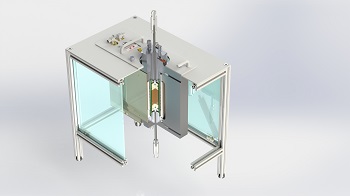Oxford Instruments and Green Imaging Technologies announce the launch of the P5 Cell for high pressure and temperature studies of petroleum reservoir rock core plugs. The P5 Cell provides NMR users with the technology to pressurise rock core samples up to 5,000 psi and heat them to 100°C, allowing them to make measurements as close to reservoir conditions as possible. The two companies have combined their world leading NMR knowledge and experience to once again advance NMR measurement capabilities in the oil and gas sector.

The P5 Cell is the first, and only, cell to be designed and built by a Nuclear Magnetic Resonance (NMR) instrument manufacturer, and hence is fully integrated with the hardware. This means that the P5 Cell minimises the undesired background signals that have been synonymous with NMR overburden studies in the past.
A unique design feature of the P5 Cell integrates the NMR coil into the cell keeping it close to the sample, maximising fill factor for optimal signal to noise ratio (SNR). This same feature also allows faster and more accurate measurements than have previously been possible in overburden studies. The cell takes full advantage of the GeoSpec Q-Sense probe technology and is the only pressure cell to do so.
The CE certified P5 Cell is one of the safest pressure cells on the market with several layers of safety features. Main pressure components are tested to 15,000 psi and each cell includes a comprehensive secondary containment system, an industry first.
“The design team’s focus on usability and safety has provided the P5 Cell with features that will allow our customers to study new and exciting things in rock cores at reservoir conditions.” said Green Imaging Technologies’ CTO Dr. Derrick Green. “The launch of this new product shows our continued commitment to offer our customers access to the most advanced, useful measurements for rock core NMR analysis in the world.”
The usability of the P5 cell is a key aspect of its innovative design. The cell can be easily inserted and removed from the NMR instrument with minimal effort, and the sample can be kept under pressure while outside the instrument. This eliminates the negative effects of pressure cycling and the need to tie up the NMR instrument for long periods. Preparations such as core aging can take place under pressure outside the instrument, so the instrument can continue to be available for measuring other samples.
Oxford Instruments and Green Imaging Technologies continue to be the market leaders in lab based NMR rock core analysis. They maintain leadership by continually evolving the GeoSpec range of products to meet and exceed user expectations. The latest evolution is the introduction of the P5 Cell for overburden studies.